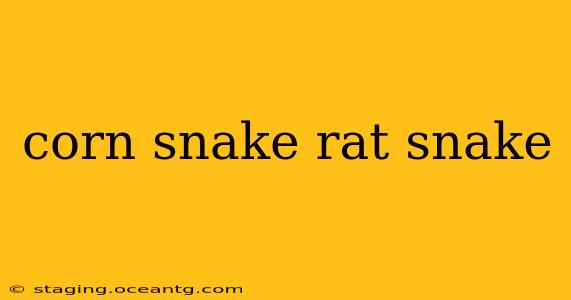Corn snakes and rat snakes are both incredibly popular pet snakes, and for good reason! They're relatively docile, relatively easy to care for, and come in a stunning array of colors and patterns. However, while they share some similarities, there are key differences that prospective owners should understand before bringing one home. This comprehensive guide will delve into the distinctions between corn snakes and rat snakes, helping you make an informed decision about which species is right for you.
What are the key physical differences between corn snakes and rat snakes?
While there's considerable variation within each species due to morphs and regional differences, some general physical characteristics can help distinguish between corn snakes and rat snakes. Corn snakes ( Pantherophis guttatus) typically have a slender build and are generally smaller than rat snakes. Their markings are distinctive – often featuring reddish-brown saddles or blotches on a tan or orange background. Rat snakes (Pantherophis species, encompassing many subspecies) tend to be larger and more robust, with patterns varying widely depending on the subspecies. Some have blotches, others stripes, and some have a more uniform coloration. Size, however, is not a definitive identifier as a large corn snake might surpass a small rat snake.
How do their temperaments and handling differ?
Both corn snakes and rat snakes are generally considered docile and relatively easy to handle, making them popular choices for beginners. However, individual temperaments can vary. Corn snakes are often lauded for their calm demeanor and their tendency to remain relatively still during handling. Rat snakes, while typically docile, can be slightly more active and prone to becoming more defensive if they feel threatened. This is not to say that rat snakes are aggressive; it simply means they might require a slightly gentler approach during handling.
What are the differences in their care requirements?
The care requirements for corn snakes and rat snakes are quite similar, as both species thrive in comparable environments. They both need appropriately sized enclosures that maintain stable temperatures and humidity levels. However, the specific size of the enclosure will vary depending on the size of the snake. Both require appropriate substrate (e.g., aspen shavings), hiding places, and water bowls. Dietary needs are also similar, with both snakes predominantly feeding on rodents. The size of the rodent offered will vary according to the snake's size and age.
What size enclosure do corn snakes and rat snakes need?
The size of the enclosure needed will depend on the age and size of the snake. A juvenile corn snake or rat snake may only require a smaller terrarium, while an adult will necessitate a significantly larger enclosure to allow for proper movement and exploration. It's crucial to research the appropriate enclosure size for the specific subspecies and age of the snake.
What kind of food do corn snakes and rat snakes eat?
Both corn snakes and rat snakes are primarily carnivorous and feed on rodents. The size and frequency of feeding will depend on the snake's size and age. Young snakes will require more frequent feedings of smaller rodents, whereas adult snakes can be fed less frequently with larger prey items.
Do corn snakes and rat snakes bite?
Both corn snakes and rat snakes are capable of biting, but they are generally considered docile and less likely to bite than many other snake species. Bites are usually infrequent and are often caused by feeling threatened or cornered. Bites are rarely serious, but appropriate handling techniques can minimize the risk.
What are the typical lifespans of corn snakes and rat snakes?
Both corn snakes and rat snakes have relatively long lifespans compared to many other snake species. Corn snakes can live for 15-20 years, and rat snakes can live for a similar duration, with some individuals even exceeding 20 years. This longevity underscores the importance of choosing a pet that you are prepared to care for long-term.
Conclusion: Choosing the Right Snake for You
Both corn snakes and rat snakes make excellent pets for experienced and novice reptile keepers alike. By understanding their subtle differences in appearance, temperament, and care requirements, you can make an informed decision about which species best suits your lifestyle and experience level. Remember to prioritize responsible pet ownership, providing proper care and ensuring the well-being of your chosen snake companion for its entire lifespan.
